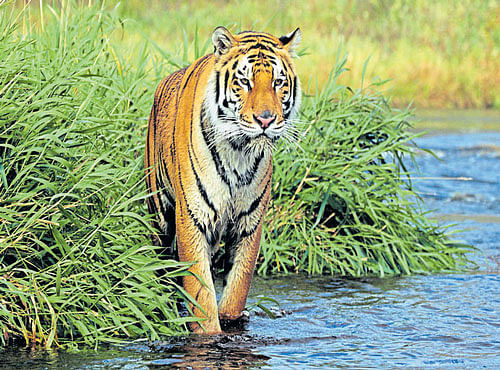Dampa: caught in the midst of all
Last Updated IST

HARMFUL The construction of Indo-Bangladesh Border Road, which cuts through the Dampa Tiger Reserve, will have devastating impacts on wildlife.
Dampa Tiger Reserve, Mizoram’s largest protected area and one of the region’s older tiger reserves, is famed for being home to primates, lesser cats and forest-birds. Spread over 500 sq km area, Dampa Tiger Reserve is not easily accessible. For instance, here, unlike other national parks, one cannot hitch a ride of a four wheeler. Instead, one has to walk through the forest if he or she wishes to sight animals.
But in recent times, many questions are being raised about Dampa. One of the main ones is regarding the human-wildlife conflict in the region. Many wonder as to why people in fringe villages talk so much of wildlife-human conflict in a landscape where population pressure is significantly less compared to other tiger reserves’? Wildlife-human conflict in this landscape has had multiple shifts in recent years. From jhum (shifting cultivation) being prevalent in the landscape earlier, we now have people moving towards cash crops, oil palm being the major culprit today. As a corollary, conflict which was primarily seasonal has now become a year-round phenomenon.
Also, confusions exist on the compensation mechanism for these cash crops. People have complained of the compensation amount being disproportionate to their losses, of inordinate delays in receiving the payments and of management not adhering to a uniform policy. As if the decreased tolerance on account of high investment was not enough, we have representatives of oil palm-promoting companies advising people to shoot wildlife that harm the plantation.
Under threatThis makes us wonder if hunting is the biggest threat to Dampa. But the reality is that habitat loss is a far bigger threat. If we continue to rid the landscape of natural vegetation, we will — in the short run, be left with a wildlife sanctuary, which is an island amidst ‘unfriendly to conservation’ plantations; in the long run, fail to protect the wildlife sanctuary itself. If we lose the sanctuary, people from fringe villages may not have any other place to get bamboo and other forest products from. Then there is the water that the oil palm coming up in the landscape will need.
Eco-development programmes don’t seem to have helped the cause. Today, there is a need to go beyond the norm. People could be encouraged and enabled to grow bamboo. It may sound funny to ask people to grow bamboo in Mizoram, a place often referred to as the bamboo state of the country. But in some villages within the tiger reserve, people are facing acute shortages of bamboo. Bamboo is not only indispensable but also intricately connected to the lives of people inhabiting the landscape: Mizos, Brus (Reangs) or Chakmas. They need to be able to get bamboo from village lands, else the wildlife sanctuary is the only option. A system to incentivise these vanishing refuges of biodiversity in village lands needs to be put in place before we lose them.
Many also wonder about the effects of Bru repatriation on this precious landscape. Local newspapers report that around 4,000-4,500 Bru (Reang) families are keen to return to Mizoram from Tripura after leaving the state during 1997, following ethnic violence over killing of a Mizo official by Bru militants.
These villages typically consist of at least 500 households. Hypothetically, even if three of these villages (or 30% of the families) were to settle in the landscape without a proper plan that looks into their needs, there is little doubt where the resources would come from. Recently, newspapers reported that the Mizoram government and the Ministry of Home Affairs have approved the Roadmap ‘V’ for the repatriation of Brus; the plan proposed resumption of repatriation from November this year. So, the threat looms large.
Apart from these issues, the Indo-Bangladesh Border Road, a portion of which will cut through the tiger reserve, has been under discussion for a decade. This stretch, approximately 60 km in length, is currently one of the critical gaps in the border road, which in this portions will include fencing and border outposts at regular intervals. The proposed road will restrict access to the river (which forms the border) and habitat beyond the river. The revised plans also include installing floodlights along the road, construction of helipads and digging of borewells at each border outpost. Their combined impact on the habitat would be devastating.
Given the recent developments in Bangladesh, the chances of this gap being addressed immediately appear high. Even the wildlife community seems to be supporting the road. The report of Management Effectiveness Evaluation (MEE) of Tiger Reserves in India: Process and Outcomes brought out by National Tiger Conservation Authority (NTCA) and Wildlife Institute of India (WII) states, “Fencing should be put in place along the Bangladesh border, over a distance of 62 km, expeditiously to stop infiltration by poachers as this stretch is the only gap in an otherwise completely fenced border.” Given the number of issues Dampa Tiger Reserve is facing, one can only hope the decision makers keep in mind the wellbeing of animals before taking any concrete step.